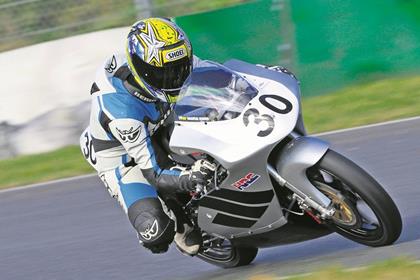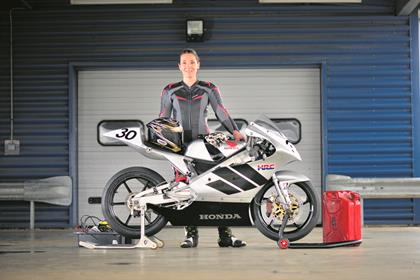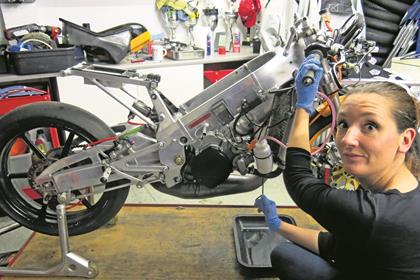Our Bikes Honda RS125
1998 Luyten-Honda RS125
“What is it? How big is it? Goes alright, doesn’t it?” Three things I hear each and every time I wheel my Honda RS125 GP bike out. First thing’s first, it’s a two-stroke, customer Grand Prix race bike from Honda, designed solely for the purpose of racing at club, national and world championship level. In fact, this exact bike helped current Superstock 1000 front-runner Lee Jackson cut his racing teeth in the British 125GP Championship back in 2010. I bought it from him in October 2012 and it’s now the love of my life.
It’s a 124.4cc (54 x 54.4mm) single cylinder two-stroke, but I’m not using the standard Honda cylinder – this is a 2010-spec ‘kit’ cylinder and matching pipe from Belgian tuner Johan Luyten, who’s currently using his Honda tuning knowledge to help Brad Binder in the Moto3 world championship. In current configuration, it revs to 13,200rpm, makes around 45bhp and generates that shove on a tightrope-like powerband just 3000rpm wide. It’s intense, tricky to ride and a lot more aggressive than many people give it credit for. Plus, the fact that it weighs just 70kg part-fuelled means that it’s also a lot faster than most people think, too. All these factors combine to make a riding experience that’s just simply out of this world. Full throttle, sixth gear, tucked in, shut off slightly then barrel in; the RS’s lack of mass makes for corner entry and mid-corner velocities that are simply unthinkable on bigger bikes. After a race, my front slick looks more tattered than a superbike’s rear. Every lap is a rush of revs, razor-sharp steering, last minute braking and constant body position shifting as I try to maintain every shred of momentum. It doesn’t matter where I’m riding it or for what reason, whether it’s testing, racing or just a trackday, it leaves me trembling for hours afterwards. I’ve been lucky enough to ride a lot of bikes, but nothing, nothing, compares to this.
The way it rides, and the resulting chemicals every session dumps into my bloodstream, is part of the reason I’m so utterly in love with it. I’m currently racing it at club meetings wherever and whenever the feeling takes me, which is currently every fortnight or so. The aim is to master the art of 125GP riding sufficiently enough so I can enter a round of the British Championship at BSB – before they pull the plug on National-level two-stroke racing – and not disgrace myself.
The other reason I love it so much is because, much like a newborn infant, it demands the utmost care and attention. Carburation, via the gaping 38mm HRC powerjet carb, needs constant adjustment depending on atmospheric conditions and circuit type. Halfway through each meeting the cylinder is removed and the piston checked for any ring problems or excessive detonation. That piston generally lasts 300 miles before I chuck it, the ring and small-end bearing, in the bin. Running past 300 miles not only reduces power as the ring’s sharp edge blunts against the cylinder, but also increases the chances of the piston shattering through fatigue. Not good.
An insanely tall first gear means the wet clutch gets an absolute hammering at race starts and slow hairpins, this means I religiously renew the gearbox oil after every meeting, and most of the clutch plates and steels every third meeting.
This isn’t as arduous as it all sounds because a) being a purpose-built race bike, everything’s designed to be stripped and rebuilt simply and quickly, b) it’s increased my mechanical and set-up know-how beyond my wildest dreams and c) every couple of weeks or so, little packages and boxes with HRC labels on them turn up in the post. What’s not to like?
All racing is addictive, but it’s even more so when you’ve got a jewel of a pukka race bike sat in the garage. With no killjoy class regulations to adhere to and a world wide web of exotic tuning parts out there to buy (or dream of buying) there’s always something fresh to get excited about. Next on the wish list is a full JHA power-valve kit, with matching ignition and pipe. This won’t necessarily give me any more power, but the power-valve will make the bike easier to ride. I’d also like some carbon wheels, carbon bodywork and a dry clutch conversion… but now I really am just dreaming.
Brake
Full Brembo set-up with Brembo 16x18mm master cylinder, GP-spec monoblock caliper featuring four golden drilled titanium-nitride pistons and a 290mm Brembo floating disc. I’m currently using EBC GPFAX pads (£54) as the Brembo Z0 pads are far too fierce.
Electronics
After spending the first season and a half running the standard ignition, I’ve now just upgraded to a BPS GP Max ignition system which offers me four different ignition/powerjet maps so I can make full use of the Luyten cylinder. It has a built-in laptimer, det light, shift light, digital display and an engine performance datalogger which I can download after each session.
Tyres
The British championship 125cc riders have to use Dunlop slicks, however I’m free to use whatever I fancy and I’ve just discovered these incredible new Bridgestones. The V02 come in all sizes, from 125GP bikes to superbikes, and they’re phenomenal. Incredible grip, decent life and predictability once they start to go past their best. I get between 150 and 200 miles out of a set (£220).
Suspension
Standard RS125 inverted fork featuring Bitubo internals (one is gold and the other silver because I bent one when I hit the tyre wall at Cadwell’s Barn corner – replacement fork tube is £160). The shock is also Bitubo, a full race item with high and low speed damping adjustment.






